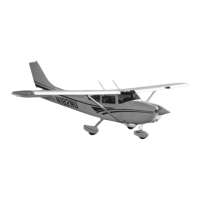SECTION 7 CESSNA
AIRPLANE AND SYSTEM DESCRIPTION MODEL T182T NAV III
GFC 700 AFCS
U.S.
FUEL SYSTEM (Continued)
FUEL DRAIN VALVES
The fuel system is equipped with drain valves to provide a means for
the examination of fuel in the system for contamination and grade. The
system should be examined before each flight and after each refueling,
by using the sampler cup provided to drain fuel from each wing tank
sump, the fuel return side sump, the fuel selector drain and the fuel
strainer sump. If any evidence of fuel contamination is found, it must be
eliminated in accordance with the preflight inspection checklist and the
discussion in Section 8. If takeoff weight limitations for the next flight
permit, the fuel tanks should be filled after each flight to prevent
condensation.
BRAKE SYSTEM
The airplane has a single-disc, hydraulically-actuated brake on each
main landing gear wheel. Each brake is connected, by a hydraulic line,
to a master cylinder attached to each of the pilot's rudder pedals. The
brakes are operated by applying pressure to the top of either the left
(pilot's) or right (copilot's) set of rudder pedals, which are
interconnected. When the airplane is parked, both main wheel brakes
may be set by utilizing the parking brake which is operated by a handle
under the left side of the instrument panel. To apply the parking brake,
set the brakes with the rudder pedals, pull the handle aft, and rotate it
90° down.
For maximum brake life, keep the brake system properly maintained,
and minimize brake usage during taxi operations and landings.
Some of the symptoms of impending brake failure are: gradual
decrease in braking action after brake application, noisy or dragging
brakes, soft or spongy pedals, and excessive travel and weak braking
action. If any of these symptoms appear, the brake system is in need of
immediate attention. If, during taxi or landing roll, braking action
decreases, let up on the pedals and then reapply the brakes with heavy
pressure. If the brakes become spongy or pedal travel increases,
pumping the pedals should build braking pressure. If one brake
becomes weak or fails, use the other brake sparingly while using
opposite rudder, as required, to offset the good brake
T182TPHBUS-00
7-56

